Mirella Sichirollo Patzer's Blog, page 10
August 22, 2016
Queen Matilde of Ringelheim - The Prophetic Queen - Book Launch Special - $2.99 until August 31st!
"I WAS BORN with the ability to prophesize thefuture. The destinies I dream about are impossible toalter, despite my many attempts to do so. With vibrant clarity, nightly visions forewarn me of good fortune, butalsoof despair, discord, and death--always death."
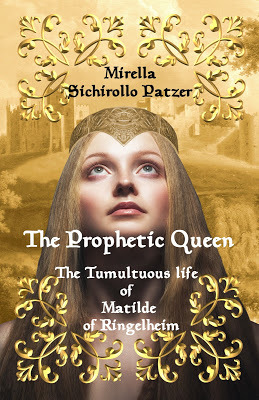 To celebrate the launch of my 6th novel, The Prophetic Queen, the ebook is on sale until August 31st for $2.99.
To celebrate the launch of my 6th novel, The Prophetic Queen, the ebook is on sale until August 31st for $2.99.
Amazon Kindle
Apple iTunes, Kobo, Barnes and Noble, and other online vendors
Matilde of Ringelheim, a paragon of virtue and achievement, a legendary woman of passion, beloved 10th-century queen, and saint of the Germanic states, was one of the most influential and charitable women in medieval history. Her story of love, family discord, betrayal, prophetic dreams, and political intrigue is an epic account of her history.
As the virtuous daughter of a noble family educated in an abbey, young Matilde faces a promising future, but she keeps a secret. Through her dreams, she can predict the future. When Duke Heinrich of Thuringia arrives unannounced at the abbey and wishes to marry Matilde, her childhood is over. At fourteen, she weds the young, enigmatic duke. She must leave everything behind and learn to navigate the intricacies and intrigues of her new life as a duchess, and later as queen.
Beset by great political intrigues, a ravaged people, fraught relationships, and yet inspired to a greater calling, Matilde sees what her future could hold if she could seize the moment—if her husband will believe in and act upon her prophetic dreams.









 To celebrate the launch of my 6th novel, The Prophetic Queen, the ebook is on sale until August 31st for $2.99.
To celebrate the launch of my 6th novel, The Prophetic Queen, the ebook is on sale until August 31st for $2.99.Amazon Kindle
Apple iTunes, Kobo, Barnes and Noble, and other online vendors
Matilde of Ringelheim, a paragon of virtue and achievement, a legendary woman of passion, beloved 10th-century queen, and saint of the Germanic states, was one of the most influential and charitable women in medieval history. Her story of love, family discord, betrayal, prophetic dreams, and political intrigue is an epic account of her history.
As the virtuous daughter of a noble family educated in an abbey, young Matilde faces a promising future, but she keeps a secret. Through her dreams, she can predict the future. When Duke Heinrich of Thuringia arrives unannounced at the abbey and wishes to marry Matilde, her childhood is over. At fourteen, she weds the young, enigmatic duke. She must leave everything behind and learn to navigate the intricacies and intrigues of her new life as a duchess, and later as queen.
Beset by great political intrigues, a ravaged people, fraught relationships, and yet inspired to a greater calling, Matilde sees what her future could hold if she could seize the moment—if her husband will believe in and act upon her prophetic dreams.










Published on August 22, 2016 17:08
August 19, 2016
Book Launch Special - The Prophetic Queen - $1.99 until August 31st!
 To celebrate the launch of my 6th novel, The Prophetic Queen, the ebook is on sale until August 31st for $1.99.
To celebrate the launch of my 6th novel, The Prophetic Queen, the ebook is on sale until August 31st for $1.99.Amazon Kindle
Apple iTunes, Kobo, Barnes and Noble, and other online vendors
Matilde of Ringelheim, a paragon of virtue and achievement, a legendary woman of passion, beloved 10th-century queen, and saint of the Germanic states, was one of the most influential and charitable women in medieval history. Her story of love, family discord, betrayal, prophetic dreams, and political intrigue is an epic account of her history.
As the virtuous daughter of a noble family educated in an abbey, young Matilde faces a promising future, but she keeps a secret. Through her dreams, she can predict the future. When Duke Heinrich of Thuringia arrives unannounced at the abbey and wishes to marry Matilde, her childhood is over. At fourteen, she weds the young, enigmatic duke. She must leave everything behind and learn to navigate the intricacies and intrigues of her new life as a duchess, and later as queen.
Beset by great political intrigues, a ravaged people, fraught relationships, and yet inspired to a greater calling, Matilde sees what her future could hold if she could seize the moment—if her husband will believe in and act upon her prophetic dreams.










Published on August 19, 2016 11:00
August 6, 2016
THE PROPHETIC QUEEN
I am excited to announce the release of my latest novel, a biographical titled THE PROPHETIC QUEEN: The Tumultuous Life of Matilde of Ringelheim.
 Matilde of Ringelheim, a paragon of virtue and achievement, a legendary woman of passion, beloved 10th-century queen, and saint of the Germanic states, was one of the most influential and charitable women in medieval history. Her story of love, family discord, betrayal, prophetic dreams, and political intrigue is an epic account of her history.
Matilde of Ringelheim, a paragon of virtue and achievement, a legendary woman of passion, beloved 10th-century queen, and saint of the Germanic states, was one of the most influential and charitable women in medieval history. Her story of love, family discord, betrayal, prophetic dreams, and political intrigue is an epic account of her history.
As the virtuous daughter of a noble family educated in an abbey, young Matilde faces a promising future, but she keeps a secret. Through her dreams, she can predict the future. When Duke Heinrich of Thuringia arrives unannounced at the abbey and wishes to marry Matilde, her childhood is over. At fourteen, she weds the young, enigmatic duke. She must leave everything behind and learn to navigate the intricacies and intrigues of her new life as a duchess, and later as queen.
Beset by great political intrigues, a ravaged people, fraught relationships, and yet inspired to a greater calling, Matilde sees what her future could hold if she could seize the moment—if her husband will believe in and act upon her prophetic dreams. Available now! AmazoniTunes, Kobo, Barnes and Noble, and Other Vendors










 Matilde of Ringelheim, a paragon of virtue and achievement, a legendary woman of passion, beloved 10th-century queen, and saint of the Germanic states, was one of the most influential and charitable women in medieval history. Her story of love, family discord, betrayal, prophetic dreams, and political intrigue is an epic account of her history.
Matilde of Ringelheim, a paragon of virtue and achievement, a legendary woman of passion, beloved 10th-century queen, and saint of the Germanic states, was one of the most influential and charitable women in medieval history. Her story of love, family discord, betrayal, prophetic dreams, and political intrigue is an epic account of her history. As the virtuous daughter of a noble family educated in an abbey, young Matilde faces a promising future, but she keeps a secret. Through her dreams, she can predict the future. When Duke Heinrich of Thuringia arrives unannounced at the abbey and wishes to marry Matilde, her childhood is over. At fourteen, she weds the young, enigmatic duke. She must leave everything behind and learn to navigate the intricacies and intrigues of her new life as a duchess, and later as queen.
Beset by great political intrigues, a ravaged people, fraught relationships, and yet inspired to a greater calling, Matilde sees what her future could hold if she could seize the moment—if her husband will believe in and act upon her prophetic dreams. Available now! AmazoniTunes, Kobo, Barnes and Noble, and Other Vendors










Published on August 06, 2016 08:49
August 1, 2016
Mary Anna Custis Lee and the Civil War
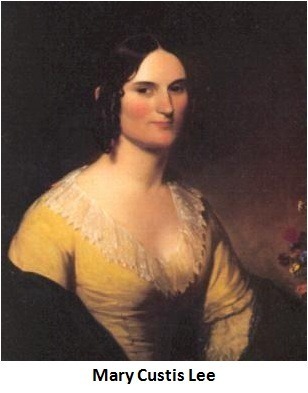 1808 to 1873
1808 to 1873Mary Anna Custis Lee was a descendant of many of the South's most notable families. Well educated, especially in Latin and Greek. Robert E. Lee was her third cousin, and as children, they played together often. An enduring love and respect was born from their childhood. Mary and Robert were married at her parents' home, Arlington House, in 1831. She bore her husband three sons and four daughters. By all accounts, their marriage was a good one, although Robert was known to criticize her housekeeping skills from time to time. She preferred domestic pursuits to socializing, but often discussed politics with her husband and father. Deeply religious, Mary held morning and evening prayers in the parlor. Upon the death of her parents, Mary inherited her beloved family home, Arlington House. While Robert was kept busy with his rising military career, Mary hosted numerous military visitors and gatherings, and spent much of her free time painting landscapes and gardening. Growing roses was a great passion of hers. Although she never freed any slaves under her care, she did teach them to read, write, and sew, believing that when they were eventually emancipated, they had the necessary skills to support themselves. As the years passed, Mary developed rheumatoid arthritis and suffered greatly. She avoided going up and down the stairs, and came down in the morning and returning upstairs at night. By the time the Civil War was in full swing, she had trouble walking. Her life became increasingly difficult and in her latter years, she required a wheelchair. As her husband and sons became embroiled in the American Civil War, and life became more dangerous, her husband pleaded with her to leave Arlington House. She hesitated leaving her home. He wrote her:
War is inevitable, and there is no telling when it will burst around you... You have to move and make arrangements to go to some point of safety which you must select. The Mount Vernon plate and pictures ought to be secured. Keep quiet while you remain, and in your preparations...May God keep and preserve you and have mercy on all our people.Mary took heed and she and her daughters moved between several family plantations. In May 1862, she was trapped by Union forces behind Federal lines, but was given safe passage and allowed to reside in Richmond. They lived there for a time, but then sought refuge at the Cocke family plantation where they remained until the end of the war. In the aftermath of the war, Robert and Mary ended up living in Lexington. Mary always yearned for her family home in Arlington. Three years after Robert died, she had the opportunity to visit her family home one last time. She could only gaze at it from her horse carriage because her rheumatoid arthritis was so severe, she could not descend. She died several months later and is buried next to her husband o the campus of Washington and Lee University.

Mary's life has been immortalized in a novel by Dorothy Love, entitled MRS. LEE AND MRS. GRAY.
A general’s wife and a slave girl forge a friendship that transcends race, culture, and the crucible of Civil War.
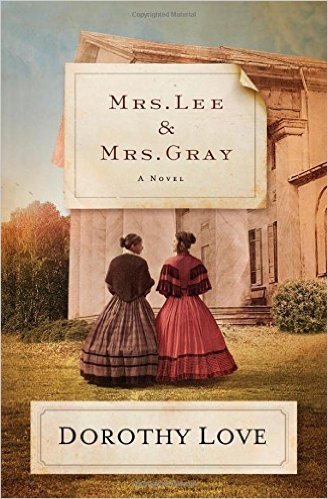 Mary Anna Custis Lee is a great-granddaughter of Martha Washington, wife of Confederate General Robert E. Lee, and heiress to Virginia’s storied Arlington house and General Washington’s personal belongings.Born in bondage at Arlington, Selina Norris Gray learns to read and write in the schoolroom Mary and her mother keep for the slave children and eventually becomes Mary’s housekeeper and confidante. As Mary’s health declines, Selina becomes her personal maid, strengthening a bond that lasts until death parts them.Forced to flee Arlington at the start of the Civil War, Mary entrusts the keys to her beloved home to no one but Selina. When Union troops begin looting the house, it is Selina who confronts their commander and saves many of its historic treasures.In a story spanning crude slave quarters, sunny schoolrooms, stately wedding parlors, and cramped birthing rooms, novelist Dorothy Love amplifies the astonishing true-life account of an extraordinary alliance and casts fresh light on the tumultuous years leading up to and through the wrenching battle for a nation’s soul.A classic American tale, Mrs. Lee and Mrs. Gray is the first novel to chronicle this beautiful fifty-year friendship forged at the crossroads of America’s journey from enslavement to emancipation.
Mary Anna Custis Lee is a great-granddaughter of Martha Washington, wife of Confederate General Robert E. Lee, and heiress to Virginia’s storied Arlington house and General Washington’s personal belongings.Born in bondage at Arlington, Selina Norris Gray learns to read and write in the schoolroom Mary and her mother keep for the slave children and eventually becomes Mary’s housekeeper and confidante. As Mary’s health declines, Selina becomes her personal maid, strengthening a bond that lasts until death parts them.Forced to flee Arlington at the start of the Civil War, Mary entrusts the keys to her beloved home to no one but Selina. When Union troops begin looting the house, it is Selina who confronts their commander and saves many of its historic treasures.In a story spanning crude slave quarters, sunny schoolrooms, stately wedding parlors, and cramped birthing rooms, novelist Dorothy Love amplifies the astonishing true-life account of an extraordinary alliance and casts fresh light on the tumultuous years leading up to and through the wrenching battle for a nation’s soul.A classic American tale, Mrs. Lee and Mrs. Gray is the first novel to chronicle this beautiful fifty-year friendship forged at the crossroads of America’s journey from enslavement to emancipation.
OPINION:
This wonderful story begins when Mary and Robert fall in love with each other. Selina is a young black slave whom Mary is teaching to read and write. Soon, Selina is put to work as a house slave, personally serving Mary and her mother. The author explores Selina's yearning for freedom and Mary's difficulties at being left alone to raise her family while her husband serves in the military. Duty, friendship, freedom, and southern culture are some of the themes the author explores in this novel. Beautifully written and well researched, the author has excelled at accurately depicting the tumultuous years before and after the Civil War, especially family/plantation life and slavery in the South. I thoroughly enjoyed learning about Mary, her endurance in the face of illness, and her dedication to her slaves. This was a touching, human story about a fascinating woman of history. Definitely worth reading!










Published on August 01, 2016 12:25
July 27, 2016
Mabel Burton Ringling - The Woman behind the Circus

Mabel Burton was born in a small town in Ohio in the year 1875. Of humble origins, she left her parents and her five siblings behind and headed to Chicago to pursue her own destiny which included not only a way to make a living, but to find herself a good husband. It is unknown exactly how she met John Ringling, but when she did, they fell in love and were soon married. She was thirty and he was thirty-nine at the time.
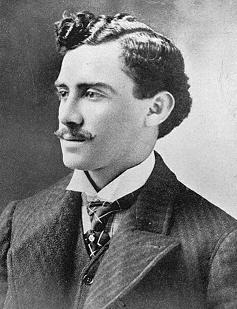 John RinglingAfter they wed, they began building their dream home in Sarasota, Florida. s, juilcmoved to Hoboken, New JerseyytJohn Nicholas Ringling. They wed in Hoboken, New Jersey when Mable was 30 and John was 39 years old.[2] John and Mabel, in 1924, began the creation of their dream home in Sarasota, Florida.
John RinglingAfter they wed, they began building their dream home in Sarasota, Florida. s, juilcmoved to Hoboken, New JerseyytJohn Nicholas Ringling. They wed in Hoboken, New Jersey when Mable was 30 and John was 39 years old.[2] John and Mabel, in 1924, began the creation of their dream home in Sarasota, Florida.

Built in the Roaring Twenties, after visiting Venice, Ca' d' Zan (House of John in the Venetian dialect), a Venetian Gothic style mansion that resembles the many elegant palazzos of Venice's Grand Canal. The 36,000 square foot mansion sits on a large waterfront and was filled with numerous expensive furnishings including rare art and intricate furnishings that she collected herself in her travels across Europe. Many rooms and items are green as this was her favourite color.
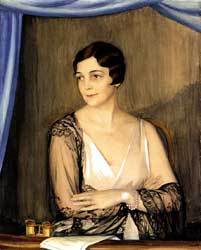
Sadly, they lived in the home for three years as Mabel died at the age of fifty-four due to Addison's Disease and Diabetes. John was devastated at the loss for he loved her greatly and it is said he never recovered. His soul mate with whom he shared a love for travel, culture, and art was gone. Mable and John are buried at the John and Mable Ringling Museum of Art, just in front and to the right of the Ca d'Zan. It is behind the Secret Garden.Author Kristy Cambron has researched Mabel's life and has written a rich tale about her quiet life, despite the fame of her name. BOOK REVIEW An ounce of courage. A leap of faith. Together, they propel two young women to chase a new life—one that’s reimagined from what they might have become.
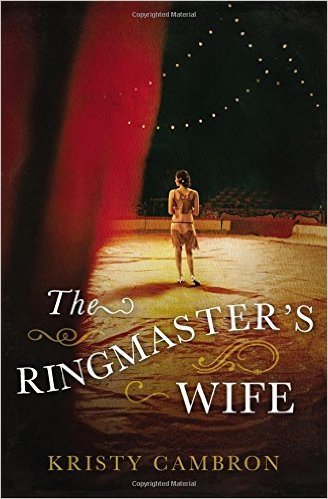 In turn-of-the-century America, a young girl dreams of a world that stretches beyond the confi nes of a quiet life on the family farm. With little more than her wit and a cigar box of treasures, Mable steps away from all she knows, seeking the limitless marvels of the Chicago World’s Fair. There, a chance encounter triggers her destiny—a life with a famed showman by the name of John Ringling.A quarter of a century later, Lady Rosamund Easling boards a ship to America as a last adventure before her arranged marriage. There, the twenties are roaring, and the rich and famous gather at opulent, Gatsby-esque parties. The Jazz Age has arrived, and with it, the golden era of the American circus, whose queen is none other than the enigmatic Mable Ringling.When Rosamund’s path crosses with Mable’s and the Ringlings’ glittering world, she makes the life-altering decision to leave behind a comfortable future of estates and propriety, choosing instead the nomadic life of a trick rider in the Ringling Brothers’ circus.A novel that is at once captivating, deeply poignant, and swirling with exquisite historical details of a bygone world, The Ringmaster’s Wife will escort readers into the center ring, with its bright lights, exotic animals, and a dazzling performance that can only be described as the Greatest Show on Earth!
In turn-of-the-century America, a young girl dreams of a world that stretches beyond the confi nes of a quiet life on the family farm. With little more than her wit and a cigar box of treasures, Mable steps away from all she knows, seeking the limitless marvels of the Chicago World’s Fair. There, a chance encounter triggers her destiny—a life with a famed showman by the name of John Ringling.A quarter of a century later, Lady Rosamund Easling boards a ship to America as a last adventure before her arranged marriage. There, the twenties are roaring, and the rich and famous gather at opulent, Gatsby-esque parties. The Jazz Age has arrived, and with it, the golden era of the American circus, whose queen is none other than the enigmatic Mable Ringling.When Rosamund’s path crosses with Mable’s and the Ringlings’ glittering world, she makes the life-altering decision to leave behind a comfortable future of estates and propriety, choosing instead the nomadic life of a trick rider in the Ringling Brothers’ circus.A novel that is at once captivating, deeply poignant, and swirling with exquisite historical details of a bygone world, The Ringmaster’s Wife will escort readers into the center ring, with its bright lights, exotic animals, and a dazzling performance that can only be described as the Greatest Show on Earth!
OPINION:
I often do judge a book by its cover, and I did so in this circumstance. Inside is a wonderful biography about a lesser known women in history. Surrounded by wonderfully quirky circus characters and a nomadic lifestyle, Mabel meets the handsome John Ringing, falls in love with him, and marries. Written in clear, moving prose, I learned about the wonderful relationships and the many kindnesses of Mabel Ringling. The secondary, fictional character in the story is another woman named Lady Rosamund Easling, a wealthy socialite who leaves her titled family and wealth to be with her horse and to join the circus in America. Although the story is not fast paced, it is very interesting and kept me hooked due to the vivid descriptions pertaining to characters and the circus itself. It is filled with emotional happenings and interesting facts. I loved every page of this book as it gave me a glimpse into a romantic way of life that is fading into the anals of history. Highly recommended. Thank you to the author and publisher. I received a free copy of this book in exchange for an honest review. Thank you for visiting my blog, http://greathistoricals.blogspot.ca, where the greatest historical fiction is reviewed! For fascinating women of history bios and women's fiction please visit http://www.historyandwomen.com.










Published on July 27, 2016 12:31
June 23, 2016
Laura Bullion - Outlaw of the Wild West
Laura Bullion: Whore, Fraud Artist, and Robber of trains and banks.
 Poor Laura, all she ever knew was a life of crime. She was introduced to crime early in her life. Her father was a notorious bank robber. At the age of 13, she became a prostitute. When she was 15, she became romantically entangled with William Carver and began to run with notorious outlaws Butch Cassidy and the Sundance Kid of the Wild Bunch. Of course, it was only natural for her to help out with a few robberies here and there, and was known for disguising herself as a man. She earned the moniker "Rose of the Wild Bunch." She continued to work as a prostitute in a San Antonio brothel until the age of 17. In between, she was very adept at pawning off stolen good and forging checks. The law caught up to her in 1901 and she was arrested and convicted of train robbery, receiving 5 years imprisonment. She served 3 years and was subsequently released. She must have learned her lesson, however, because she immediately gave up her life of crime and lived her life quietly thereafter.
Poor Laura, all she ever knew was a life of crime. She was introduced to crime early in her life. Her father was a notorious bank robber. At the age of 13, she became a prostitute. When she was 15, she became romantically entangled with William Carver and began to run with notorious outlaws Butch Cassidy and the Sundance Kid of the Wild Bunch. Of course, it was only natural for her to help out with a few robberies here and there, and was known for disguising herself as a man. She earned the moniker "Rose of the Wild Bunch." She continued to work as a prostitute in a San Antonio brothel until the age of 17. In between, she was very adept at pawning off stolen good and forging checks. The law caught up to her in 1901 and she was arrested and convicted of train robbery, receiving 5 years imprisonment. She served 3 years and was subsequently released. She must have learned her lesson, however, because she immediately gave up her life of crime and lived her life quietly thereafter.










 Poor Laura, all she ever knew was a life of crime. She was introduced to crime early in her life. Her father was a notorious bank robber. At the age of 13, she became a prostitute. When she was 15, she became romantically entangled with William Carver and began to run with notorious outlaws Butch Cassidy and the Sundance Kid of the Wild Bunch. Of course, it was only natural for her to help out with a few robberies here and there, and was known for disguising herself as a man. She earned the moniker "Rose of the Wild Bunch." She continued to work as a prostitute in a San Antonio brothel until the age of 17. In between, she was very adept at pawning off stolen good and forging checks. The law caught up to her in 1901 and she was arrested and convicted of train robbery, receiving 5 years imprisonment. She served 3 years and was subsequently released. She must have learned her lesson, however, because she immediately gave up her life of crime and lived her life quietly thereafter.
Poor Laura, all she ever knew was a life of crime. She was introduced to crime early in her life. Her father was a notorious bank robber. At the age of 13, she became a prostitute. When she was 15, she became romantically entangled with William Carver and began to run with notorious outlaws Butch Cassidy and the Sundance Kid of the Wild Bunch. Of course, it was only natural for her to help out with a few robberies here and there, and was known for disguising herself as a man. She earned the moniker "Rose of the Wild Bunch." She continued to work as a prostitute in a San Antonio brothel until the age of 17. In between, she was very adept at pawning off stolen good and forging checks. The law caught up to her in 1901 and she was arrested and convicted of train robbery, receiving 5 years imprisonment. She served 3 years and was subsequently released. She must have learned her lesson, however, because she immediately gave up her life of crime and lived her life quietly thereafter.










Published on June 23, 2016 13:29
June 16, 2016
Dawn at Emberwilde (A Treasures of Surrey Novel Book 2) by Sarah E Ladd
Isabel Creston never dared to dream that love could be hers. Now, at the edge of a forest filled with dark secrets, she faces a fateful choice between love and duty.
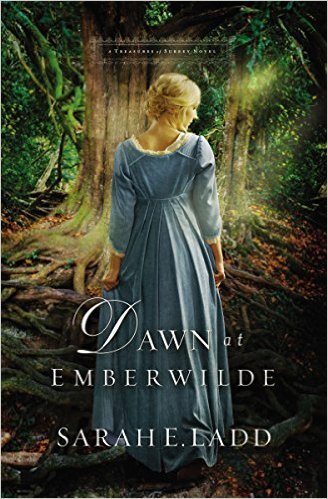 For as long as she can remember, beautiful and free-spirited Isabel has strained against the rules and rigidity of the Fellsworth School in the rolling English countryside. No longer a student, Isabel set her sights on a steady role as a teacher at the school, a safe yet stifling establishment that would enable her to care for her younger sister Lizzie, who was left in her care after her father’s death. The unexpected arrival of a stranger with news of unknown relatives turns Isabel’s small, predictable world upside down, sweeping her and her young charge into a labyrinth of intrigue and hidden motives.At her new family’s invitation, Isabel and Lizzie relocate to Emberwilde, a sprawling estate adjacent to a vast, mysterious wood rife with rumors and ominous folklore—along with whispers of something far more sinister. Perhaps even more startling, two handsome men begin pursuing Isabel, forcing her to learn the delicate dance between attraction, the intricate rules of courtship, and the hopes of her heart. At Emberwilde Isabel will discover that the key to unlocking the mystery of her past may also open the door to her future and security. But first she must find it—in the depths of Emberwilde Forest.Electronic File Size: 2138 KBPrint Length: 348 pagesPublisher: Thomas Nelson (May 10, 2016)Publication Date: May 10, 2016Sold by: HarperCollins Christian Publishing
For as long as she can remember, beautiful and free-spirited Isabel has strained against the rules and rigidity of the Fellsworth School in the rolling English countryside. No longer a student, Isabel set her sights on a steady role as a teacher at the school, a safe yet stifling establishment that would enable her to care for her younger sister Lizzie, who was left in her care after her father’s death. The unexpected arrival of a stranger with news of unknown relatives turns Isabel’s small, predictable world upside down, sweeping her and her young charge into a labyrinth of intrigue and hidden motives.At her new family’s invitation, Isabel and Lizzie relocate to Emberwilde, a sprawling estate adjacent to a vast, mysterious wood rife with rumors and ominous folklore—along with whispers of something far more sinister. Perhaps even more startling, two handsome men begin pursuing Isabel, forcing her to learn the delicate dance between attraction, the intricate rules of courtship, and the hopes of her heart. At Emberwilde Isabel will discover that the key to unlocking the mystery of her past may also open the door to her future and security. But first she must find it—in the depths of Emberwilde Forest.Electronic File Size: 2138 KBPrint Length: 348 pagesPublisher: Thomas Nelson (May 10, 2016)Publication Date: May 10, 2016Sold by: HarperCollins Christian Publishing
Opinion:It is no secret that I am a big fan of a line of books published by Thomas Nelson Publishers and HarperCollins Christian Publishing. They always come with spectacular covers, wonderfully rich storylines, and terrific authors. Although there is always a romantic thread going through each novel, it is only a secondary element. These books have class, enduring plots, and characters that bloom from every page. Dawn at Emberwilde by Sarah E Ladd is one such book. Although it is the second book in a series, you do not have to read Book One to fully grasp and enjoy this novel.
I loved this novel. It's set in England's Regency period. The story unfolds at a very steady pace, always tantalizing me to read further. Reading was like a discovery of secrets and characters and a very enjoyable experience. There is plenty to laud - a smuggling mystery, a meddling aunto, an enigmatic strong hero, life adversity, and wonderfully evolving secondary characters.









 For as long as she can remember, beautiful and free-spirited Isabel has strained against the rules and rigidity of the Fellsworth School in the rolling English countryside. No longer a student, Isabel set her sights on a steady role as a teacher at the school, a safe yet stifling establishment that would enable her to care for her younger sister Lizzie, who was left in her care after her father’s death. The unexpected arrival of a stranger with news of unknown relatives turns Isabel’s small, predictable world upside down, sweeping her and her young charge into a labyrinth of intrigue and hidden motives.At her new family’s invitation, Isabel and Lizzie relocate to Emberwilde, a sprawling estate adjacent to a vast, mysterious wood rife with rumors and ominous folklore—along with whispers of something far more sinister. Perhaps even more startling, two handsome men begin pursuing Isabel, forcing her to learn the delicate dance between attraction, the intricate rules of courtship, and the hopes of her heart. At Emberwilde Isabel will discover that the key to unlocking the mystery of her past may also open the door to her future and security. But first she must find it—in the depths of Emberwilde Forest.Electronic File Size: 2138 KBPrint Length: 348 pagesPublisher: Thomas Nelson (May 10, 2016)Publication Date: May 10, 2016Sold by: HarperCollins Christian Publishing
For as long as she can remember, beautiful and free-spirited Isabel has strained against the rules and rigidity of the Fellsworth School in the rolling English countryside. No longer a student, Isabel set her sights on a steady role as a teacher at the school, a safe yet stifling establishment that would enable her to care for her younger sister Lizzie, who was left in her care after her father’s death. The unexpected arrival of a stranger with news of unknown relatives turns Isabel’s small, predictable world upside down, sweeping her and her young charge into a labyrinth of intrigue and hidden motives.At her new family’s invitation, Isabel and Lizzie relocate to Emberwilde, a sprawling estate adjacent to a vast, mysterious wood rife with rumors and ominous folklore—along with whispers of something far more sinister. Perhaps even more startling, two handsome men begin pursuing Isabel, forcing her to learn the delicate dance between attraction, the intricate rules of courtship, and the hopes of her heart. At Emberwilde Isabel will discover that the key to unlocking the mystery of her past may also open the door to her future and security. But first she must find it—in the depths of Emberwilde Forest.Electronic File Size: 2138 KBPrint Length: 348 pagesPublisher: Thomas Nelson (May 10, 2016)Publication Date: May 10, 2016Sold by: HarperCollins Christian Publishing
Opinion:It is no secret that I am a big fan of a line of books published by Thomas Nelson Publishers and HarperCollins Christian Publishing. They always come with spectacular covers, wonderfully rich storylines, and terrific authors. Although there is always a romantic thread going through each novel, it is only a secondary element. These books have class, enduring plots, and characters that bloom from every page. Dawn at Emberwilde by Sarah E Ladd is one such book. Although it is the second book in a series, you do not have to read Book One to fully grasp and enjoy this novel.
I loved this novel. It's set in England's Regency period. The story unfolds at a very steady pace, always tantalizing me to read further. Reading was like a discovery of secrets and characters and a very enjoyable experience. There is plenty to laud - a smuggling mystery, a meddling aunto, an enigmatic strong hero, life adversity, and wonderfully evolving secondary characters.









Published on June 16, 2016 10:02
May 24, 2016
Was Aemilia Bassano Lanier Shakespeare's Dark Lady?
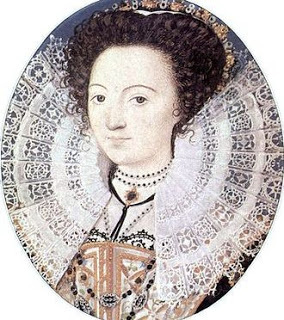
Was Aemilia Bassano Lanier Shakespeare’s Dark Lady?
Born in 1569, Aemilia Bassano Lanier (also spelled Lanyer) was the highly cultured daughter of an Italian court musician—a man thought to have been a Marrano, a secret Jew living under the guise of a Christian convert.
After her father’s death, seven-year-old Aemilia was fostered by Susan Bertie, the Dowager Countess of Kent, who gave her young charge the kind of humanist education generally reserved for boys in that era. Later, after Bertie remarried and moved to the Netherlands, Aemilia became the mistress of Henry Carey, Lord Chamberlain to Queen Elizabeth. As Carey’s paramour, Aemilia Bassano enjoyed a few years of glory in the royal court—an idyll that came to an abrupt and inglorious end when she found herself pregnant with Carey’s child. She was then shunted off into an unhappy arranged marriage with Alfonso Lanier, a court musician and scheming adventurer who wasted her money. So began her long decline into obscurity and genteel poverty, yet she triumphed to become a ground-breaking woman of letters.
Aemilia Bassano Lanier was the first English woman to aspire to a career as a professional poet by actively seeking a circle of eminent female patrons to support her. She praises these women in the dedicatory verses to her epic poem, Salve Deus Rex Judaeorum, a vindication of the rights of women couched in religious verse and published in 1611.
But was Lanier also the mysterious Dark Lady of Shakespeare’s sonnets, as the late A. L. Rowse famously proclaimed?
Shakespeare’s Dark Lady Sonnet Sequence (sonnets 127-152) describes a woman with an “exotic” dark beauty that sets her apart from the pale English roses. Musically gifted, she plays the virginals like a virtuosa, winning the poet’s heart. She is also of tarnished reputation—a woman of bastard birth and a married woman who lures the likewise married Shakespeare into a shameful, doubly-adulterous affair. Alas, the lady proves capricious and unfaithful, and the bitter end of their affair leaves her poet-lover roiling with disgust. Shakespeare describes her as “my female evil.”
Over the centuries Shakespearean scholars have tried to deduce the Dark Lady’s identity. Candidates include Lucy Morgan, a London brothel owner of African ancestry; and Sara Fitton, lady-in-waiting to Elizabeth I.
Aemilia Bassano Lanier herself seems to fit the bill. A woman of Italian-Jewish heritage, it’s plausible that she had raven-black hair and an olive complexion. Her parents’ common-law marriage meant that she was officially classed as a bastard. The illegitimate son she had with the Lord Chamberlain did nothing to shore up her reputation. As a court musician’s daughter and later another court musician’s unwilling wife, it’s likely that she was musically accomplished and a deft hand at the virginals. After being jilted by the Lord Chamberlain and thrust into a forced marriage with a man she detested, she may well have been tempted to look for love elsewhere. The Lord Chamberlain, interestingly enough, was also Shakespeare’s patron, the money behind his theatre company, Lord Chamberlain’s Men.
However, none of this proves that Lanier was the Dark Lady, or even that there was a Dark Lady. Academic scholars will point out that we don’t even know if Shakespeare’s sonnets were autobiographical. Lanier scholars in particular find the Dark Lady question an unwelcome detraction from Lanier’s own considerable literary achievements.
Having established these facts, I must confess that as a novelist I could not resist the allure of the Dark Lady myth. As Kate Chedgzoy points out in her essay “Remembering Aemilia Lanyer” in the Journal of the Northern Renaissance, this myth endures because it draws on “our continuing cultural investment in a fantasy of a female Shakespeare.”
My intention was to write a novel that married the playful comedy of Marc Norman and Tom Stoppard’s Shakespeare in Love to the unflinching feminism of Virginia Woolf’s meditations on Shakespeare’s sister in A Room of One’s Own. How many more obstacles would an educated and gifted Renaissance woman poet face compared with her ambitious male counterpart?
In The Dark Lady’s Mask, I explore what happens when a struggling young Shakespeare meets a struggling young woman poet of equal genius and passion. If Lanier and Shakespeare were lovers, would this explain how Shakespeare made the leap from his history plays to his Italian comedies and romances—the turning point of his career? Lanier, after all, was an Anglo-Italian trapped in a miserable arranged marriage. The names Aemilia, Emilia, Emelia, and Bassanio all appear in Shakespeare’s plays. His Italian comedies are set in Veneto, Lanier’s ancestral homeland. What if Shakespeare’s early comedies were the fruit of an active collaboration between him and Lanier?
I find it fascinating how the strong, outspoken women of Shakespeare’s early Italian comedies, such as the crossdressing Rosalind in As You Like It and the spirited Beatrice in Much Ado About Nothing, gave way to much weaker heroines and misogynistic portraits of women in Shakespeare’s great tragedies, such as frail, mad Ophelia in Hamlet. This change in tack leads me to wonder if the historical Shakespeare actually did have a bittersweet affair with a mysterious, unknown woman that cast a shadow over his later life and work.
Most intriguingly, Lanier’s own proto-feminist Salve Deus Rex Judaeorum was published in the wake of Shakespeare’s sonnets bitterly mocking his Dark Lady. If she and Shakespeare were estranged lovers, was this her spirited riposte to his defamation of her character? Did the woman Shakespeare maligned as his “female evil” pick up her pen in her own defense and in defense of all women?
These two poets had such radically different character arcs. We all know about Shakespeare’s rise to the glory that would enshrine him as an enduring cultural icon. But there was no meteoric rise for Lanier. Though she eventually triumphed to become a published poet, she died in obscurity and has only recently been rediscovered by scholars.
In my novel I wanted to redress the balance by writing Aemilia Bassano Lanier back into history. Her life and work stand in direct opposition to Virginia Woolf’s pronouncement in “A Room of One’s Own” that “it would have been . . . completely and entirely impossible, for any woman to have written the plays of Shakespeare in the age of Shakespeare.” Although Lanier may not have been a playwright, her achievement as a poet speaks for itself. Whether or not she was Shakespeare’s Dark Lady, muse, lover, or collaborator, she has certainly earned her place in history as Shakespeare’s peer.
Mary Sharratt’s novel, The Dark Lady’s Mask: A Novel of Shakespeare’s Muse, is published by Houghton Mifflin Harcourt. Visit her website: www.marysharratt.com.
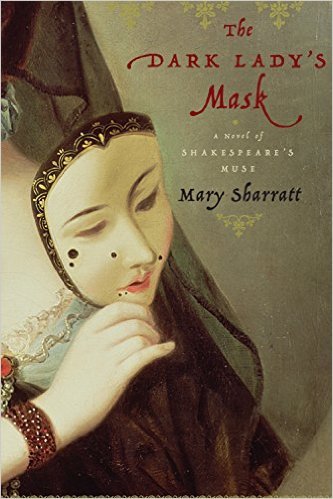 Shakespeare in Love meets Shakespeare’s Sister in this novel of England’s first professional woman poet and her collaboration and love affair with William Shakespeare.
Shakespeare in Love meets Shakespeare’s Sister in this novel of England’s first professional woman poet and her collaboration and love affair with William Shakespeare.
London, 1593. Aemilia Bassano Lanier is beautiful and accomplished, but her societal conformity ends there. She frequently cross-dresses to escape her loveless marriage and to gain freedoms only men enjoy, but a chance encounter with a ragged, little-known poet named Shakespeare changes everything. Aemilia grabs at the chance to pursue her long-held dream of writing and the two outsiders strike up a literary bargain. They leave plague-ridden London for Italy, where they begin secretly writing comedies together and where Will falls in love with the beautiful country — and with Aemilia, his Dark Lady. Their Italian idyll, though, cannot last and their collaborative affair comes to a devastating end. Will gains fame and fortune for their plays back in London and years later publishes the sonnets mocking his former muse. Not one to stand by in humiliation, Aemilia takes up her own pen in her defense and in defense of all women. The Dark Lady’s Mask gives voice to a real Renaissance woman in every sense of the word.
Review:
The Dark Lady’s Mask is intriguing, especially because it is based on a true historical person who knew Shakespeare. Aemilia was a writer herself, a poet who could read Greek and Latin. Most fascinating of all is that she often wore male clothing and was well traveled. In Mary Sharratt's novel, the premise is that she was not only Shakespeare's lover, but also his muse. Although no one will ever know the secrets of their relationship. this book was a great imagining of a possible love story between the two writers. Mary Sharratt writes lovely, easy to enjoy, luscious prose which truly brought this period to life as I read along. I truly enjoyed the novel and highly recommend it to anyone who loves historical biographies or who are followers of the great Shakespeare!










Published on May 24, 2016 16:00
April 20, 2016
The Suffragette who wrote THE BATTLE HYMN OF THE REPUBLIC
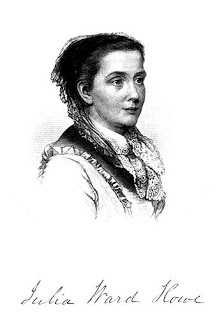
Heiress, poet, and suffragette, Julia Ward Howe became famous as the writer of the BATTLE HYMN OF THE REPUBLIC. Written in 1861, it was the most famous patriotic anthem of the Civil War, and remains highly popular to this day. Thereafter, for her entire life, she was asked to read or sing it wherever she went. Her life, and the story behind this infinite song is recreated in the novel, THE CIVIL WARS OF JULIA WARD HOWE.
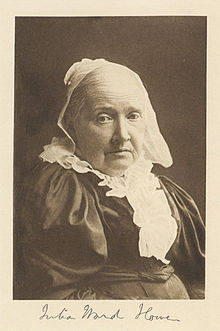
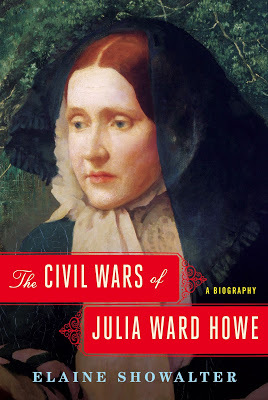 The first full biography of Julia Ward Howe—the author of The Battle Hymn of the Republic and an early and powerful feminist pioneer—a groundbreaking figure in the abolitionist and suffrage movements.
The first full biography of Julia Ward Howe—the author of The Battle Hymn of the Republic and an early and powerful feminist pioneer—a groundbreaking figure in the abolitionist and suffrage movements.Julia Ward (1819–1910) was a heiress and aspiring poet when she married Dr. Samuel Gridley Howe, an internationally-acclaimed pioneer in the education of the blind. Together the Howes knew many of the key figures of their era, from Charles Dickens to John Brown. But he also wasted her inheritance, isolated and discouraged her, and opposed her literary ambitions. Julia persisted, and continued to publish poems and plays while raising six children.
Authorship of the Battle Hymn of the Republic made her celebrated and revered. But Julia was also continuing to fight a civil war at home; she became a pacifist, suffragist, and world traveler. She came into her own as a tireless campaigner for women’s rights and social reform. Esteemed author Elaine Showalter tells the story of Howe’s determined self-creation and brings to life the society she inhabited and the obstacles she overcame.
MY REVIEW
It is not often that I switch from historical fiction to historical non-fiction, but in the case of this book, THE CIVIL WARS OF JULIA WARD HOWE, I'm glad I did. This book truly read like a novel at times and it was so interesting, that I eagerly flipped pages. Julia was born into wealth, but married a man of the middle class. What began as a loving relationship, slowly turned into a relationship of restriction and oppressiveness for Julia. Her talent as a poet/writer was continually suppressed by her husband. And although he didn't want to have anything to do with her money at first, that changed too, and he began to take advantage by purchasing and selling property with her funds. She was rarely happy and the marriage continued to deteriorate. Nevertheless, despite all her struggles, all the suppression, all the suffocation and stifling she endured, Julia rose courageously. She gained resounding success with her poem THE BATTLE HYMN OF THE REPUBLIC, and acquired great fame as a suffragette fighting for women's rights. She worked tirelessly for her charities too.
I completely came to admire this wonderful woman and am so proud of her achievements. This book is definitely recommended for women everywhere as it gives us all hope that we can endure and persevere no matter the adversity we may face!










Published on April 20, 2016 14:17
April 13, 2016
Until Death Do Us Part - The Love Story of Harry and Bess Houdini
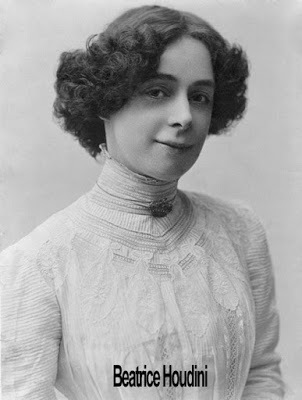
Their love was so great, Houdini was determined that not even death could part them!
Weighing only 98 lbs with a size 1 shoe, Wilhelmina Beatrice Rahner was a good Roman Catholic girl working as a singing and dancing act called THE FLORAL SISTERS in Coney Island in 1894. That was when she met Harry, a magician who performed with his brother Theo in an act called THE BROTHERS HOUDINI.
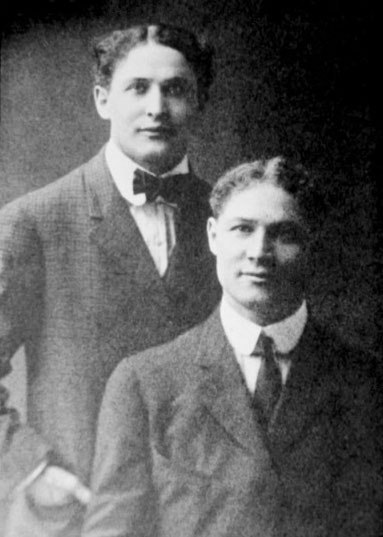 Harry and Theo
Harry and Theo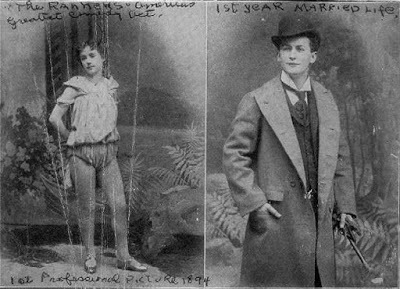
Bess and Harry in 1894
It was love at first sight and Bess married Harry 3 weeks later. They were both 18 years old. Not long after their marriage, Harry and Theo disbanded their struggling magic act and Harry went solo, focusing more on escape tricks with his beautiful new wife as his assistant in the act. Her tiny physique made him look bigger on stage and her presence on stage enhanced his popularity.
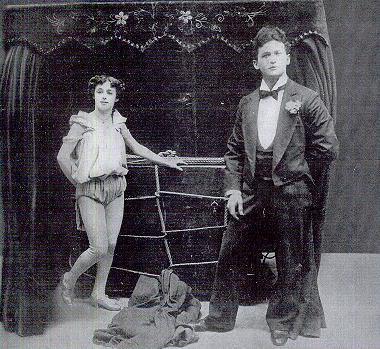
For years and years Bess and Houdini worked hard to build up their act. They performed in circuses, museums, and anywhere else they could get exposure. With Bess at his side, Houdini advertised he had "escaped out of more handcuffs, manacles, and leg shackles than any other human being living."
Marriage was not easy. Both were known for their strong, quick-to-anger, and stubborn personalities. It didn't help that Harry had controlling and perfectionist tendencies. During an argument, Harry would leave and take a walk to cool off. When he returned, he would throw his hat into the room before entering. If she threw it back out, he knew she was still angry.

Despite their frequent spats, Harry was kind and romantic, often writing her love notes and letters. He even had her wedding ring engraved with the word ROSABELE, the first song he heard her sing.
Rosabelle, sweet Rosabelle,I love you more than I can tell.Over me you cast a spell.I love you my sweet Rosabelle.
Bess loved him deeply and she was loyal to him and her marriage. Over the years, he wrote hundreds of love letters to her, many of which were written in her presence. Whenever they were together, they lovingly addressed each other as Mr. Houdini or Mrs. Houdini.

But Harry had another sweetheart - his mother. Their love and bond was profound. So it's a good thing Harry's Jewish mother approved of his petite Catholic wife. He loved both women deeply, but Harry always referred to his mother as “the guiding beacon of my life.”
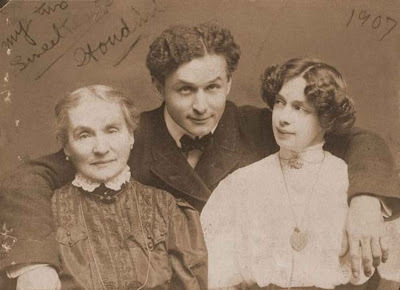
As the popularity of their act grew, they departed for a grand tour of Europe. His fame grew and he was acclaimed as a brilliant "escapologist."
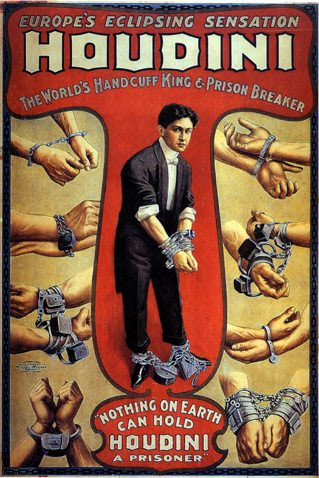 Bess proved herself to be a wonderful manager, taking on the task of taking care of their menagerie of pets while collecting dolls and sewing the costumes for Houdini's shows. They loved children, but sadly, could have none of their own due to Bess who had a medical condition that prevented her from having children.Years later, they celebrated their 20th wedding anniversary on board the S.S. Imperator of the Hamburg-America Line. Fellow passenger, Theodore Roosevelt. Roosevelt was so impressed with Harry's escapes, he invited them to meet his grandchildren.After 39 years of happy marriage, on October 31, 1926, Harry died from peritonitis (inflammation of the lining of the abdominal cavity).
Bess proved herself to be a wonderful manager, taking on the task of taking care of their menagerie of pets while collecting dolls and sewing the costumes for Houdini's shows. They loved children, but sadly, could have none of their own due to Bess who had a medical condition that prevented her from having children.Years later, they celebrated their 20th wedding anniversary on board the S.S. Imperator of the Hamburg-America Line. Fellow passenger, Theodore Roosevelt. Roosevelt was so impressed with Harry's escapes, he invited them to meet his grandchildren.After 39 years of happy marriage, on October 31, 1926, Harry died from peritonitis (inflammation of the lining of the abdominal cavity).

They wanted to be buried together, so his headstone included Bess for when her time came.
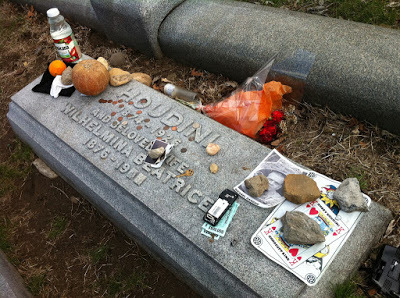
Bess was distraught at his death and attended many séances hoping to speak with Harry and prove that he could escape the afterlife, but all attempts failed.

The Last Seance Bess held for Harry

In 1936, on the anniversary of Harry's death, Bess attended a final seance. When it failed to conjure Harry, she blew out the candle next to a photograph of Houdini.
 Bess Houdini died from a heart attack on February 11, 1943 while aboard an eastbound train traveling from Los Angeles to New York City. She was 67 years old. Because she was Catholic, her family refused to bury her body next to Harry according to his grave. She was instead interred at Gate of Heaven Cemetery in Hawthorne, New York.
Bess Houdini died from a heart attack on February 11, 1943 while aboard an eastbound train traveling from Los Angeles to New York City. She was 67 years old. Because she was Catholic, her family refused to bury her body next to Harry according to his grave. She was instead interred at Gate of Heaven Cemetery in Hawthorne, New York.

The fascinating love story of this famous couple is brilliantly retold in the novel, Mrs. Houdini by Victoria Kelly by Simon and Schuster Canada.
 Before escape artist Harry Houdini died, h vowed he would find a way to speak to his beloved wife Bess from beyond the grave using a coded message known only to the two of them. When a widowed Bess begins seeing this code in seemingly impossible places, it becomes clear that Harry has an urgent message to convey. Unlocking the puzzle will set Bess on a course back through the pair’s extraordinary romance, which swept the illusionist and his bride from the beaches of Coney Island, to the palaces of Budapest, to the back lots of Hollywood. When the mystery finally leads Bess to the doorstep of a mysterious young photographer, she realizes that her husband’s magic may have been more than just illusion.
Before escape artist Harry Houdini died, h vowed he would find a way to speak to his beloved wife Bess from beyond the grave using a coded message known only to the two of them. When a widowed Bess begins seeing this code in seemingly impossible places, it becomes clear that Harry has an urgent message to convey. Unlocking the puzzle will set Bess on a course back through the pair’s extraordinary romance, which swept the illusionist and his bride from the beaches of Coney Island, to the palaces of Budapest, to the back lots of Hollywood. When the mystery finally leads Bess to the doorstep of a mysterious young photographer, she realizes that her husband’s magic may have been more than just illusion.In surprising turns that weave through the uncertain days of the dawn of the twentieth century and continue into the dazzling 1920s, Mrs. Houdini is a thrilling tale that will take you deep into the heart of one of history’s greatest love stories—asking what drives people to believe in something bigger than themselves—even as it reveals the famous magician’s most remarkable feat of all.
REVIEW
Harry Houdini has fascinated numerous generations of magic lovers. His life and rise to fame, along with his great love for his wife, Bess, has intrigued many, but I liked that the focus of this story was on Bess instead of her famous husband. The novel covers her life from when she first met Harry until long after he died, and her tumultuous life thereafter.
Told through several points of view, I found the novel inclusive of many factors in this couples lives - Harry's great love for his mother, Bess's wisdom when dealing with her husband's controlling personality, their fascination with spiritualism, to name a few. Bess's grief is explored as she desperately anticipates that he will reach out from beyond the grave to communicate his secret code as per their pact. There were numerous settings too from New York to Europe and ocean liners.
Filled with compelling characters, exciting locations, and eloquent prose, this is a lovely way to learn more about the woman behind the great escape artist, Harry Houdini!










Published on April 13, 2016 14:00



